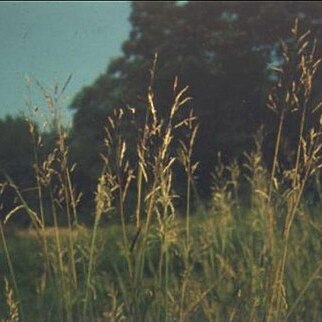Perennial, tufted. Culms erect or decumbent at base, fairly robust, up to 130 cm tall, many-noded, nodes glabrous or appressed bearded. Leaf sheaths glabrous; leaf blades linear, 10–40 × 0.2–1 cm, hairy with tubercle-based hairs on both surfaces or abaxial surface glabrous, apex finely acuminate; ligule 0.5–1.5 mm. Inflorescence 9–20 cm, composed of many racemes borne in loose whorls along an elongate central axis, axis usually longer than lowest raceme, sometimes paniculate with branchedpeduncles; racemes 2–5 cm, often purplish, not obviously hairy; rachis internodes and pedicels thinly ciliate, shortly bearded at apex. Sessile spikelet 3–4 mm; lower glume narrowly oblong-lanceolate, herbaceous or cartilaginous and glossy, 5–7-veined, back slightly concave, glabrous or pubescent below middle, sometimes with a pit, margins keeled and scabrid near apex; awn of upper lemma 1–2.5 cm. Pedicelled spikelet barren or rarely staminate, narrower than sessile spikelet, sometimes pitted. Fl. and fr. Jul–Oct. 2n = 40, 60, 80.
Tufted perennial, 0.6-1.8 m high. Leaf blade 100-550 x 2-12 mm; ligule a fringed membrane, hairs shorter than membrane. Inflorescence paniculate, of > 20 racemes, axis longer than racemes; pedicels and internodes longitudinally grooved with a translucent median line; pedicel hairs usually < 1 mm long; spikelets paired: one sessile, other pedicelled. Sessile spikelet 3-4 mm long, dorsiventrally compressed; lower glume acute to subacute, pitted or pits absent. Florets 2; lower floret sterile, reduced to hyaline lemma, awnless; upper floret bisexual, lemma less firm than glumes, entire; awn 10-18 mm long, glabrous; callus hairs usually < 1 mm long; anther 1.0-1.5 mm long. Pedicelled spikelet smaller than sessile, awnless, sterile, usually reduced, lower glumes pitted. Flowering time Dec.-June.
Sessile spikelet 3–4 mm long, barbate at the base; inferior glume pilose below the middle on the back, rarely glabrous, rigidly ciliate on the margins above, depressed along the middle, with a deep or shallow pit in the upper part, the pit sometimes absent in some spikelets, rarely absent altogether; superior glume lanceolate, the margins sparsely ciliate above or glabrous, depressed along both sides of the keel, the keel scabrid above; inferior floret empty, the lemma oblong, obtuse, glabrous; superior floret epaleate, with stipitiform lemma; awn 10–18 mm long, geniculate, glabrous; anthers c. 1.5 mm long.
Tufted perennial; culms 50–150 cm. high, erect from a shortly rhizomatous base, often robust.. Leaf-blades 10–55 cm. long, 2–12 mm. wide.. Inflorescence with a central axis 4–20 cm. long, the racemes numerous and borne loosely or densely in irregular whorls upon simple or branched peduncles; racemes 2–5 cm. long (the lowest shorter than the central axis), pubescent.. Sessile spikelet narrowly elliptic, 3–4 mm. long; lower glume chartaceous, ± hairy below the middle, usually not glossy, with or without a pit; awn 10–25 mm. long.. Pedicelled spikelet glabrous, with 0–3 pits.
Tufted perennial 600-1800 mm high. Leaf blade 100-550 x 2-12 mm; ligule a fringed membrane, hairs shorter than membrane. Inflorescence axis longer than racemes; racemes more than 20; pedicel hairs usually shorter than 1 mm long. Sessile spikelet 3-4 mm long; lower glume pitted; callus hairs usually shorter than 1 mm; anthers 1.0-1.5 mm long.
Caespitose perennial of variable habit; culms up to 100 cm high, rather straggling, the nodes glabrous, the internodes terete or channelled on one side; leaf sheaths barbate at the base; ligule membranous; leaf laminas up to 30 cm × 10 mm, almost glabrous, tapering gradually to a slender apex.
Inflorescence paniculate, with numerous slender branches 2–5 cm long on a common axis 3–10 cm long; lowermost branches sometimes themselves branched; spikelets usually dark purple or flushed with purple; rhachis internodes and pedicels pilose with hairs up to 2.5 mm long.
Perennial, tufted, up to 1.8 m high. Leaf blades 100-550 mm long, 2-12 mm wide. Spikelets (sessile) 3-4 mm long. Inflorescence axis longer than racemes; racemes more than 20, pedicel and callus hairs usually shorter than 1 mm; lower glumes pitted.
Pedicelled spikelet usually smaller than the sessile spikelet and reduced to 1 or 2 glumes, rarely well developed and with the inferior glume pitted.
Tufted perennial up to 1 m. high.

